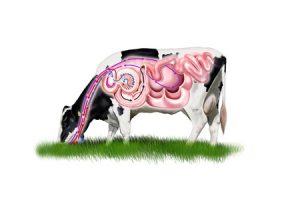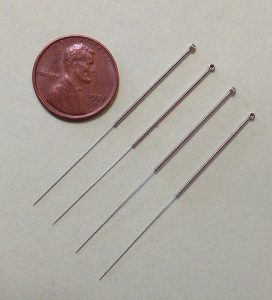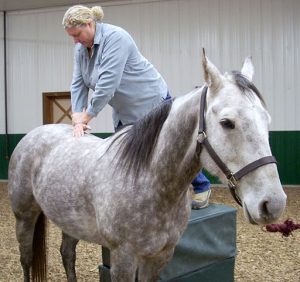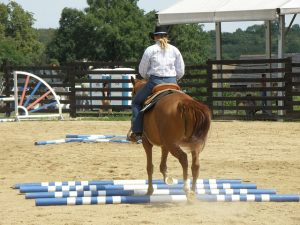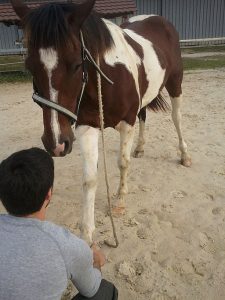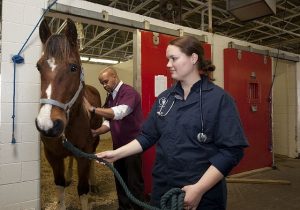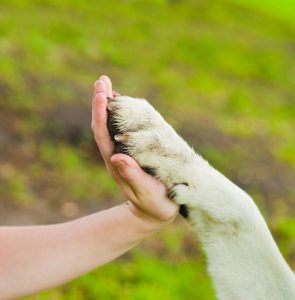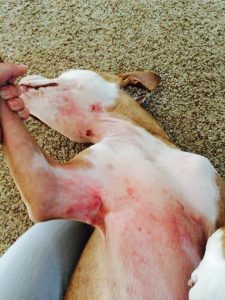You’re eating dinner with your family and you just so happen to have a leftover slice of chicken on your plate that you aren’t going to eat. Your four-legged canine friend is staring up at you with those forlorn puppy-dog eyes that you can never resist. You subtly slide him your leftovers which he joyously gobbles up in a nano-second, then immediately looks up at you for more. While this chicken tidbit may not seem like a harmful treat, there are some real dangers and inconveniences that can be caused by feeding your dogs human food. This being said, there are also some specific occasions where certain human foods might make a healthy treat for your furry pal.
Allergic Reactions
First of all, there are the dangers of food allergies if your dog tries a sample of human food. These include your dog’s individual allergies, and the things that EVERY dog must avoid at all costs. There are a vast multitude of human foods that can be deadly for your dog if they manage to get their teeth on them. This list includes:
- Garlic
- Onions
- Avocado
- Caffeine
- Grapes and raisins
- Macadamia nuts
- Chocolate
- Salt
- Sugary foods and drinks
- Candy
- Raw meat
These are just some of the foods that dogs cannot have under ANY circumstances whatsoever. While they all have different dangers and different levels of toxicity, there is absolutely no reason to feed your dog even the smallest amount of these foods. They will cause some serious damage down the line.
There is also the issue of your dog having allergies to foods other than the dangerous ones listed. For example, my dog is extremely allergic to all grain and potato. These can both be found in processed dog food, but her reactions are much worse if she gets them in their purer forms, such as in bread or as French fries. Your dog could be having an allergic reaction to something you’re feeding them, and you may not notice until they’re covered in a rash and hives. Only feeding them dog food greatly reduces this risk, and it makes it easier to discover what they’re really allergic to since the ingredients are listed right on the bag.
Over Feeding
One of the more obvious problems with feeding dogs human food is over feeding. Since dogs are so much smaller than humans, increasing their intake even by a few table scraps can cause obesity to set in quickly. Premade dog food provides all of the nutrition that your dog needs, so adding human food as a “treat” on top of their regular portion of food tends to fatten them up and take them out of their ideal weight range which can then lead to even more health issues.
Below, there are two different dog nutrition calculators that can help you balance out your dog’s diet. The first one will show you the appropriate serving size of dog food for your dog based on the calorie content listed on their food bag. The second calculator helps you find the ideal weight for your dog and a suggested feeding amount based on the number of calories they are currently ingesting.
Begging
Your dog’s health isn’t the only reason why you should avoid giving them human food. There is also the major concern of bad manners and begging. While some people think it’s cute to see their fluffy little dog stare up at them lovingly for a scrap of bacon, it can actually be a sign of a dog who needs more training. If you leave food on a low table, will your dog grab it like it was his all along? Do you have to guard your plate while you’re eating so he doesn’t steal any morsels you that aren’t willing to give away? These are all signs that your pal could use some more training to be less tempted by human treats.
If your dog sees or believes that his food is the same as yours, why wouldn’t he take it when he has a chance? These bad behaviors can be trained away relatively easily, but the first step will always be to stop feeding your dog scraps from the table. Here is a helpful site about training away begging and bad table manners that could help you going in the right direction. If you live locally, check out the amazing Claren Wilson at Cloud K-9!
Healthy Dog Food Alternatives
Now that we have discussed the dangers of human foods, it is also important to know that there are always exceptions to the rule. While the dangerous parts of human food should always be avoided, dogs can occasionally enjoy food that doesn’t come in kibble form.
Very specifically prepared human food can be enjoyed by dogs in moderation. For example, if your dog is having stomach problems, your vet might recommend feeding them a diet of white rice and boiled chicken for a few days to help clear out their system. For this, you’d have to make sure the chicken has no seasonings added to it and is boiled in water, not chicken broth. Broth usually contains garlic and onion which is toxic to dogs. If your dog is having diarrhea, pureed pumpkin added to their food will help firm up their poo thanks to the high fiber content.
Fruits and veggies can also provide your dog with a healthy, low calorie treat that can even be frozen to give your dog some tasty relief on a hot summer day. Some healthy options are:
- Apples (minus the seeds and core)
- Strawberries
- Oranges
- Blueberries
- Mango (remove the large pit)
- Carrots
- Cucumbers
- Celery (remove the leaves)
Some other options may cause diarrhea so they are recommended for use in smaller servings. These include:
- Watermelon (avoid seeds)
- Bananas
- Pineapple
- Broccoli
- Peaches (no pit)
It is important to always clean the fruits and veggies before feeding them to your dog, and make sure any large pits or sharp bits are removed. My dog acts like watermelon is the most amazing substance to be created, especially if its frozen (even though it gives her particularly nasty poo). I don’t allow her to have any human food scraps, so when she gets a frozen watermelon popsicle, she acts like it’s her birthday, Thanksgiving, and Christmas all wrapped into one. I would definitely recommend treating your dog with fruits and veggies, especially if you are trying to slim them down. They are usually lower calorie than regular dog treats, and cheaper too! Just watch very carefully for any signs of allergies or upset stomach with each new food your dog tries.
Now even though fruits and veggies can make a great addition to your dog’s diet as a snack or treat between meals, it is very important to realize that dogs cannot survive on veggies alone. Some owners might be tempted to put their dog on a vegetarian diet, but this could be detrimental to their health. Melvin Pena explains that, “A purely vegetarian diet exposes dogs to musculoskeletal issues, vision disorders — including blindness — chronic urinary tract infections, and cardiovascular disease. For instance, a balanced diet for dogs strengthens and sustains the heart muscle; without the nutrients a dog needs, the heart muscle becomes enlarged and weakened, contributing to cumulative and irreversible problems like congestive heart failure.”
Dogs should not be vegetarian simply because of the way their bodies are designed to process food. Carnivores have very short, simple digestive systems because meat can be broken down and absorbed quickly. Herbivores, however, have very long digestive systems due to the complexity of breaking down vegetables and grains. For example, think of the amazing four-compartment stomach that cows have! They need their intricately designed stomach and their 170 foot long small intestines just to digest the grass and grain that they’re eating. All of this takes up to three days! Dogs, on the other hand, have a very small single chamber stomach with extremely acidic digestive enzymes to break down meat, which occurs in only 4-6 hours. Clearly, dogs do not have the proper digestive system for a vegetarian diet: your dog is not a cow. Many dog food brands offer grain-free options since it just goes through the dog without being properly digested.
Another good alternative to human food is high quality healthy dog food. If your dog refuses to eat anything but human food, the experts at Better Life Natural Pet Foods can help you find a healthy food that your dog will love. There are countless options available that are much healthier for your dog than human food, and odds are these folks will be able to help. A good option for you might be a fresh, refrigerated dog food called Freshpet. It is made with all-natural ingredients and might make your dog think they’re eating a gourmet steak dinner, even though it’s actually just a healthy dog food. It is possible to change the way your dog eats and, odds are, it’ll be easier than it seems.
If you are concerned with your dog’s eating habits, you’re thinking of changing their diet, your dog is on a vegetarian diet, or you are considering a vegetarian diet, please visit your vet and ask them for more advice. Getting your dog on the proper diet is quite difficult, so it’s good to know that you can have your vet to lean on. Ohio State University’s Veterinary Medical Center has provided a very convenient diet history form that you can print out and complete before visiting your vet, so they will have all of the information they need to help you and your furry friend.
Lastly, there are ways to reward your dog that don’t involve any food whatsoever. We typically think of treats as the only way we can let our dogs know they’re being good, but it can actually be communicated by participating in some of their favorite activities, as well. Instead of giving your dog a hamburger or ice cream for being especially well-behaved, take them on a hike, to a park, go jogging with them, or just play a simple game of fetch in the back yard. Get them good and tired and then maybe treat them to a lovely watermelon popsicle for dessert. It is entirely possible to bond with your dog and spoil them without feeding them unhealthy human food. While it might be a hard transition at first, it’ll be worth it when your lifelong companion is as healthy and happy as they can possibly be.
Jessica Smith, Associate Editor, having been raised in a household full of dogs, guinea pigs, hamsters, and all things furry, Jessica’s love of animals has only grown over the years. She is currently volunteering for Safe Haven Animal Sanctuary in her free time when she isn’t out and about with her ridiculous pit bull mix, Annabel Lee, or taking care of her remarkably ancient guinea pig, Moose. She is also putting her literature degree to use by working as an editor for a local online magazine, Independent Noise. While she has no plans for the future, she knows that it will be filled with fur and fiction galore. You can e-mail Jessica at associateeditorjessica@yourpetspace.info






